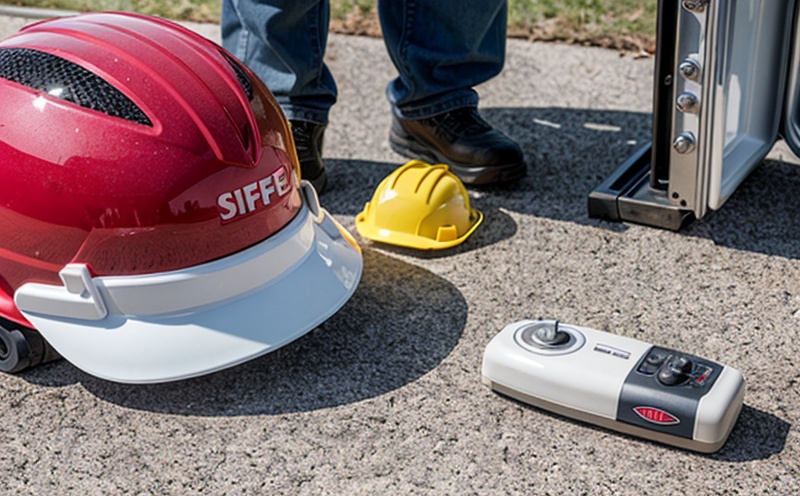ISO 18825 Rescue Boat Buoyancy Testing
The ISO 18825 standard provides a comprehensive framework for testing rescue boats to ensure they meet the stringent requirements set forth by maritime safety regulations. This service focuses on assessing the buoyancy and stability of rescue boats, ensuring they can effectively perform their critical role in emergency situations.
Compliance with ISO 18825 is crucial because it ensures that rescue boats are not only capable of floating but also provide a safe environment for occupants during rescue operations. The standard mandates tests to evaluate the buoyancy performance, which is critical for ensuring that the boat remains afloat under various loading conditions and environmental factors.
The testing process involves a series of rigorous evaluations that simulate real-world scenarios where the boat might be used. These include static and dynamic buoyancy tests conducted in controlled environments such as indoor swimming pools or dedicated test facilities. The specimens—rescue boats—are subjected to loadings representative of typical rescue missions, including full occupancy and various equipment configurations.
During these tests, critical parameters are monitored using high-precision instrumentation. These include the boat's displacement, center of buoyancy, and center of gravity, which determine its stability in water. Additionally, tests assess how well the boat maintains its position when subjected to wind forces or waves, ensuring it remains stable and secure for occupants.
The data collected during these tests is used to generate detailed reports that outline the boat's performance metrics against ISO 18825 requirements. These reports are essential for quality managers and compliance officers as they provide a clear indication of whether the rescue boats meet international safety standards. For R&D engineers, this service offers invaluable insights into design improvements needed to enhance buoyancy and stability.
Compliance with ISO 18825 is not just about meeting regulatory requirements; it's about ensuring that every rescue boat performs its critical function effectively and safely. This service plays a vital role in safeguarding lives at sea by providing robust, reliable data on the buoyancy performance of these essential safety equipment.
For procurement teams, this testing ensures that they are sourcing products that meet global standards, thereby minimizing risks associated with substandard equipment. The detailed reports generated from these tests can be used to inform purchasing decisions, ensuring that only high-quality rescue boats are procured and deployed.
Benefits
The benefits of ISO 18825 Rescue Boat Buoyancy Testing extend beyond mere compliance; they provide tangible advantages to all stakeholders involved in maritime safety. For quality managers, the testing ensures that products meet stringent international standards, reducing the risk of non-compliance penalties and enhancing brand reputation.
Compliance officers can leverage these tests to verify that all rescue boats are up-to-date with the latest regulations, ensuring ongoing compliance. R&D engineers benefit from detailed performance data that can be used to refine designs and improve product offerings. Procurement teams gain confidence in purchasing high-quality equipment by verifying compliance through independent testing.
By investing in ISO 18825 Rescue Boat Buoyancy Testing, organizations demonstrate a commitment to safety and excellence, which is crucial for maintaining trust with customers and regulatory bodies. The testing also supports continuous improvement initiatives, ensuring that rescue boats are not only safe but optimized for performance.
Ultimately, this service contributes significantly to the overall maritime safety ecosystem by providing critical data that ensures the reliability and effectiveness of rescue boats in real-world scenarios. This enhances the confidence of all parties involved, from manufacturers to end-users, in the products they deploy.
Industry Applications
| Application | Description |
|---|---|
| Civilian Maritime Operations | Involves rescue operations, search and recovery missions. |
| Coastal Navigation | Ensures vessels are equipped with safe and reliable life-saving appliances. |
| Offshore Oil and Gas Industry | Promotes safety during emergencies in remote locations. |
| Shipping Companies | Maintains fleet readiness for emergency response capabilities. |
| Emergency Services | Supports rapid and effective rescue operations in challenging environments. |
| Fishing Industry | Ensures fishing vessels are equipped with safe and reliable life-saving appliances. |
| Inland Waterways | Promotes safety during emergencies in inland waterways. |
Competitive Advantage and Market Impact
Compliance with ISO 18825 Rescue Boat Buoyancy Testing provides a significant competitive advantage in the maritime equipment market. Organizations that invest in this service demonstrate their commitment to safety, regulatory compliance, and excellence, which can enhance brand reputation and customer trust.
The detailed reports generated from these tests serve as a benchmark for quality, ensuring that products meet or exceed international standards. This can differentiate companies from competitors who may not offer the same level of testing and verification. For procurement teams, sourcing ISO 18825-compliant equipment is seen as an investment in safety and reliability, which can lead to long-term cost savings due to reduced risks associated with substandard products.
The market impact of this service extends beyond individual organizations; it contributes to the broader maritime safety ecosystem by promoting best practices in life-saving appliance design and manufacturing. This collective effort enhances overall industry standards, ensuring that all stakeholders—from manufacturers to end-users—are equipped with reliable and safe rescue boats.
In conclusion, ISO 18825 Rescue Boat Buoyancy Testing is not just a compliance requirement; it is an essential tool for maintaining competitive advantage and driving market impact in the maritime industry. By adhering to this standard, organizations can ensure that their products meet the highest safety standards, thereby building trust and confidence among all stakeholders.





